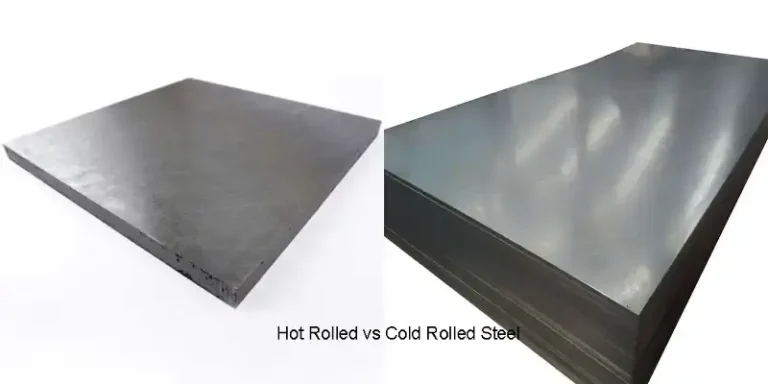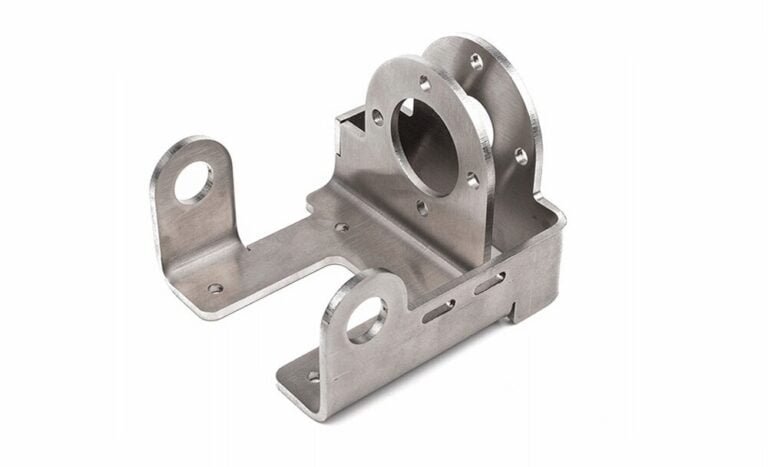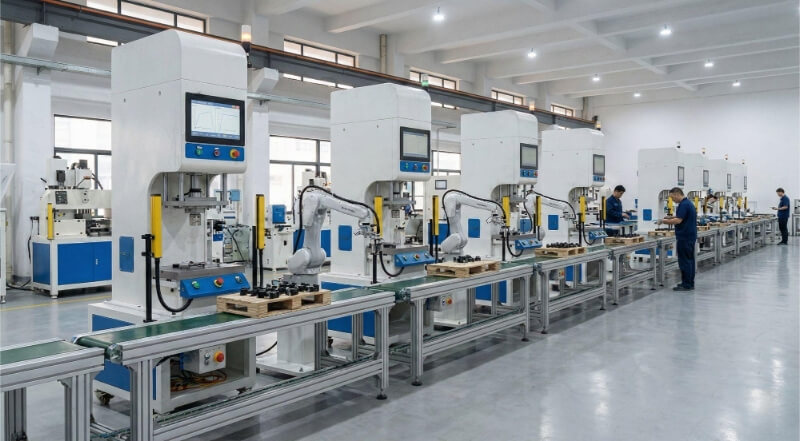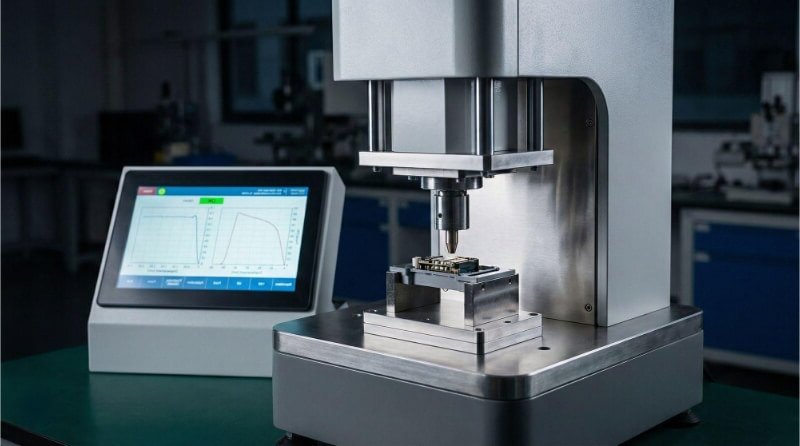Stahl ist einer der vielseitigsten Werkstoffe, die heute in der Industrie verwendet werden. Unabhängig davon, ob Sie konstruieren oder fertigen, ist es wichtig, den Unterschied zwischen warmgewalztem und kaltgewalztem Stahl zu kennen. Jeder Typ hat seine eigenen Vorteile, und die Wahl des richtigen Typs kann das Ergebnis Ihres Projekts erheblich beeinflussen.
Warmgewalzter Stahl wird durch Erhitzen von Metall auf über 1700°F und Walzen in Form gebracht. Kaltgewalzter Stahl wird bei Raumtemperatur verarbeitet, wodurch er glatter und präziser wird. Der Hauptunterschied? Festigkeit, Oberfläche und Kosten.
Um sicherzustellen, dass Sie den richtigen Stahl für Ihre Anwendung wählen, ist es wichtig zu wissen, wie sich diese Unterschiede auf Kosten, Festigkeit und Leistung auswirken. Werfen wir einen genaueren Blick auf beide Optionen.
Was ist Warmwalzen?
Warmwalzen ist ein Verfahren, bei dem Stahl auf eine sehr hohe Temperatur erhitzt wird, in der Regel zwischen 1.700 und 2.100°F, also über seinen Rekristallisationspunkt. Nach dem Erhitzen wird der Stahl durch Walzen geführt, um ihn zu Blechen, Platten oder Trägern zu formen. Durch die Hitze wird der Stahl weicher und lässt sich leichter formen.
Eigenschaften von warmgewalztem Stahl
Warmgewalzter Stahl hat mehrere wichtige Eigenschaften, die ihn für bestimmte Anwendungen geeignet machen:
- Grobe Oberflächenbearbeitung: Durch die hohen Temperaturen während des Prozesses hat der Stahl oft eine raue Oberfläche. Es kann eine zusätzliche Behandlung erforderlich sein, wie Schleifen oder Beschichtungfür ein glatteres Finish.
- Niedrigere Kosten: Das Warmwalzen ist ein effizientes und kostengünstiges Verfahren, das für viele Projekte eine kostengünstige Option darstellt.
- Große, strukturelle Formen: Warmgewalzter Stahl kann zu großen und dicken Profilen geformt werden. Das macht ihn ideal für Konstruktionsteile wie Träger und Säulen.
- Geringere Festigkeit und Toleranzen: Warmgewalzter Stahl ist zwar flexibel, hat aber eine geringere Festigkeit und weniger Präzision als kaltgewalzter Stahl. Er weist auch größere Toleranzen auf.
Warmwalzprozess
Beim Warmwalzen wird der Stahl zunächst in einem Ofen erhitzt. Sobald er die richtige Temperatur erreicht hat, wird er durch Walzen geführt, um ihn in dünne Bleche oder lange Stäbe zu pressen und zu formen. Anschließend wird der Stahl abgekühlt und auf die gewünschte Größe zugeschnitten. Dieses Verfahren ist schnell, kostengünstig und eignet sich gut für die Formgebung großer und schwerer Profile.
Temperaturen und mechanische Eigenschaften
Die Temperatur, bei der der Stahl gewalzt wird, beeinflusst seine endgültigen Eigenschaften. Höhere Temperaturen machen den Stahl weicher und verformbarer. Dies ermöglicht zwar eine leichtere Formgebung, kann aber die Zugfestigkeit des Stahls verringern.
Das Ergebnis ist eine rauere Oberfläche und größere Toleranzen im Vergleich zu kaltgewalztem Stahl. Das Verfahren ist jedoch kostengünstiger. Es eignet sich gut für Anwendungen, bei denen keine hohe Präzision erforderlich ist.
Was ist Kaltwalzen (CRS)?
Kaltwalzen (CRS) ist ein Verfahren, bei dem Stahl bei Raumtemperatur oder unterhalb seines Rekristallisationspunktes geformt wird. Dies geschieht, nachdem der Stahl bereits warmgewalzt wurde. Beim Kaltwalzen wird der Stahl unter hohem Druck komprimiert, wodurch er dünner und gleichmäßiger wird. Durch dieses Verfahren werden auch die mechanischen Eigenschaften, die Oberflächenbeschaffenheit und die Toleranz des Stahls verbessert.
Merkmale von kaltgewalztem Stahl
Kaltgewalzter Stahl hat mehrere entscheidende Vorteile, insbesondere bei Anwendungen, die eine höhere Präzision erfordern:
- Glatte Oberflächenbeschaffenheit: Kaltgewalzter Stahl hat im Vergleich zu warmgewalztem Stahl eine glattere Oberfläche. Dies macht ihn ideal für Projekte, bei denen es auf das Aussehen ankommt, wie z. B. bei Automobil- oder Geräteteilen.
- Höhere Stärke: Das Kaltwalzen erhöht die Zugfestigkeit von Stahl. Dadurch wird er fester und haltbarer, ideal für Produkte, die einer höheren Belastung und Abnutzung ausgesetzt sind.
- Engere Toleranzen: Kaltgewalzter Stahl hat genauere Abmessungen und eine gleichmäßige Dicke. Dies macht ihn ideal für Anwendungen, die enge Toleranzen erfordern.
- Erhöhte Härte: Durch das Kaltwalzen wird der Stahl auch härter. Er wird widerstandsfähiger gegen Verformung und eignet sich daher für Präzisionsteile von Maschinen.
Kaltwalzprozess
Beim Kaltwalzen wird der Stahl nach dem Warmwalzen abgekühlt und dann bei Raumtemperatur oder etwas höheren Temperaturen durch Walzen geführt. Der Stahl wird komprimiert, um seine Dicke zu verringern. Durch dieses Verfahren wird auch das Korngefüge gestrafft, wodurch sich die Oberflächenbeschaffenheit und die mechanischen Eigenschaften verbessern.
Das Kaltwalzen wird normalerweise für dünnere Bleche und detailliertere Formen verwendet. Anschließend wird der Stahl häufig wärmebehandelt oder geglüht um Spannungen abzubauen und die Duktilität zu verbessern.
Temperaturen und mechanische Eigenschaften
Das Kaltwalzen erfolgt bei niedrigeren Temperaturen als das Warmwalzen, normalerweise bei Raumtemperatur. Dieser Temperaturunterschied wirkt sich stark auf die mechanischen Eigenschaften des Stahls aus. Kaltgewalzter Stahl ist fester und härter, weil seine Kornstruktur kompakter ist. Allerdings kann er auch spröder sein, vor allem wenn die Dicke erheblich reduziert wird.
Das Kaltwalzen verbessert die Oberflächengüte und die Präzision. Dies macht es zur bevorzugten Wahl für Anwendungen, die diese Eigenschaften benötigen, wie Teile für die Automobil- und Unterhaltungselektronikindustrie.

Hauptunterschiede zwischen warmgewalztem und kaltgewalztem Stahl
Die Entscheidung zwischen warmgewalztem und kaltgewalztem Stahl hängt von den spezifischen Anforderungen Ihres Projekts ab. Vergleichen wir die beiden Stahlsorten in einigen wichtigen Bereichen.
Temperatur und ihr Einfluss auf die Stahlkonstruktion
Die Temperatur, bei der Stahl verarbeitet wird, beeinflusst seine Struktur.
- Warmgewalzten Stahl: Warmgewalzter Stahl, der bei hohen Temperaturen (1.700°F bis 2.100°F) verarbeitet wird, hat ein lockereres Korngefüge, wodurch er leichter zu formen ist. Diese Struktur kann jedoch zu einer geringeren Zugfestigkeit im Vergleich zu kaltgewalztem Stahl führen.
- Kaltgewalzter Stahl: Kaltgewalzter Stahl, der bei oder nahe der Raumtemperatur verarbeitet wird, hat eine engere Kornstruktur, was seine Härte und Festigkeit erhöht. Das macht ihn haltbarer, aber er kann in bestimmten Situationen auch spröder sein.
Prozessunterschiede: Heiß und kalt
Warm- und Kaltwalzen sind sehr unterschiedliche Verfahren.
- Warmwalzen: Der Stahl wird auf hohe Temperaturen erhitzt und durch große Walzen geführt, um ihn zu formen. Dieses Verfahren eignet sich am besten für die Herstellung größerer, dickerer Stahlprofile wie Balken und Bleche.
- Kaltwalzen: Nach dem Warmwalzen wird der Stahl bei Raumtemperatur verarbeitet. Dies führt zu dünneren, präziser geformten Profilen. Durch das Kaltwalzen werden auch die Abmessungen und die Oberflächengüte des Stahls verbessert.
Auswirkungen auf die mechanischen Eigenschaften
Die mechanischen Eigenschaften der beiden Stahlsorten unterscheiden sich aufgrund der Prozesse, die sie durchlaufen.
- Warmgewalzten Stahl: Da er bei hohen Temperaturen geformt wird, hat warmgewalzter Stahl eine geringere Zugfestigkeit und weniger Präzision. Er ist gut für Anwendungen geeignet, die keine engen Toleranzen erfordern.
- Kaltgewalzter Stahl: Das Kaltwalzverfahren erhöht die Festigkeit und Härte des Stahls. Es ist perfekt für Anwendungen, die Präzision erfordern. Kaltgewalzter Stahl ermöglicht auch engere Toleranzen und eine bessere Verformbarkeit.
Oberflächengüte und Erscheinungsbild
Die Oberflächenbeschaffenheit ist einer der auffälligsten Unterschiede zwischen den beiden.
- Warmgewalzten Stahl: Warmgewalzter Stahl hat aufgrund der hohen Temperaturen oft eine raue, verzunderte Oberfläche. Zur Verbesserung seines Aussehens kann eine zusätzliche Bearbeitung, wie Schleifen oder Beschichten, erforderlich sein.
- Kaltgewalzter Stahl: Kaltgewalzter Stahl hat eine glatte, veredelte Oberfläche. Dadurch ist er optisch ansprechender und ideal für Anwendungen, bei denen es auf das Aussehen ankommt, wie bei Konsumgütern.
Kostenvergleich
Warmgewalzter Stahl ist in der Regel kostengünstiger als kaltgewalzter Stahl.
- Warmgewalzten Stahl: Das Verfahren ist kostengünstiger, weil es weniger Schritte umfasst und nicht die Präzision des Kaltwalzens erfordert.
- Kaltgewalzter Stahl: Das Kaltwalzen erfordert mehr Arbeitsschritte und präzisere Maschinen, was es zu einer kostspieligeren Option macht. Die höhere Festigkeit, die glattere Oberfläche und die engeren Toleranzen machen die zusätzlichen Kosten für bestimmte Anwendungen jedoch lohnenswert.
| Besonderheit | Warmgewalzten Stahl | Kaltgewalzter Stahl |
|---|---|---|
| wird bearbeitet | Einstufiges Warmwalzen bei hohen Temperaturen | Mehrstufiger Prozess: Warmwalzen, Reinigen, Kaltwalzen und (optional) Glühen |
| Oberfläche | Rau, Walzzunder | Glatte, saubere Oberfläche |
| Maßtoleranzen | Lockerere Toleranzen | Engere Toleranzen |
| Stärke | Gute Gesamtfestigkeit | Höhere Festigkeit |
| Duktilität | Dehnbarer | Etwas weniger dehnbar |
| Kosten | Wirtschaftlicher | Teurer |
| Häufige Anwendungen | Bauwesen, Fahrzeugrahmen, Maschinenkomponenten | Haushaltsgeräte, Möbel, Karosserieteile, Elektronik |
Warmgewalzter vs. kaltgewalzter Stahl: Vor- und Nachteile
Sowohl warmgewalzter als auch kaltgewalzter Stahl haben ihre Vor- und Nachteile. Ihre Wahl hängt von den spezifischen Bedürfnissen und Anforderungen Ihres Projekts ab. Um Ihnen die Entscheidung zu erleichtern, wollen wir die Vor- und Nachteile der beiden Stahlsorten aufschlüsseln.
Warmgewalzter Stahl: Vor- und Nachteile
Vorteile:
- Niedrigere Kosten: Warmgewalzter Stahl ist preiswerter, weil der Herstellungsprozess einfacher ist und weniger Schritte umfasst.
- Schnellere Produktion: Das Warmwalzen ist schneller und daher eine gute Wahl für die Produktion von Großserien.
- Große Größe und Formflexibilität: Warmgewalzter Stahl kann zu größeren und dickeren Profilen verarbeitet werden und eignet sich daher ideal für Konstruktionsteile wie Träger und große Rohre.
Nachteile:
- Grobe Oberflächenbearbeitung: Die Oberfläche von warmgewalztem Stahl ist oft rau und uneben, so dass zusätzliche Arbeiten wie Schleifen oder Beschichten für eine glattere Oberfläche erforderlich sind.
- Untere Präzision: Warmgewalzter Stahl ist weniger präzise als kaltgewalzter Stahl. Er ist nicht ideal für Projekte, die enge Toleranzen erfordern.
- Reduzierte Stärke: Warmgewalzter Stahl hat im Allgemeinen eine geringere Festigkeit und ist daher für Anwendungen, die eine höhere Festigkeit erfordern, nicht geeignet.
Kaltgewalzter Stahl: Vor- und Nachteile
Vorteile:
- Höhere Festigkeit und Langlebigkeit: Das Kaltwalzen erhöht die Festigkeit und die Härte des Stahls, so dass er sich für Hochleistungsanwendungen eignet.
- Bessere Oberflächenqualität: Kaltgewalzter Stahl hat eine glatte, veredelte Oberfläche und ist daher ideal für Produkte, die eine saubere Oberfläche benötigen.
- Engere Toleranzen: Kaltgewalzter Stahl bietet eine höhere Präzision und bessere Maßgenauigkeit, was für Teile, die genau zusammenpassen müssen, wichtig ist.
Nachteile:
- Höhere Kosten: Kaltgewalzter Stahl ist teurer, da das Verfahren komplizierter und zeitaufwändiger ist.
- Sprödigkeit: Kaltgewalzter Stahl ist fester, kann aber auch spröder sein, insbesondere wenn er gehärtet wurde. Dies kann ihn in bestimmten Situationen anfälliger für Risse machen.
- Begrenztere Optionen für Größe und Form: Kaltgewalzter Stahl ist in der Regel auf dünnere Bleche und schmalere Profile beschränkt, so dass er für größere Bauvorhaben weniger geeignet ist.
Warmgewalzter vs. kaltgewalzter Stahl: Anwendungen
Sowohl warmgewalzter als auch kaltgewalzter Stahl werden in verschiedenen Branchen verwendet, eignen sich aber aufgrund ihrer einzigartigen Eigenschaften am besten für unterschiedliche Anwendungen. Sehen wir uns an, wo jede Stahlsorte in der Praxis am besten eingesetzt wird.
Warmgewalzter Stahl Anwendungen
Bauwesen und Infrastruktur
Warmgewalzter Stahl wird in der Bauindustrie häufig für Baumaterialien wie Balken verwendet, feuerfeste Türund Strukturplatten. Die großen Abmessungen und die niedrigeren Kosten machen sie ideal für große Bauprojekte, bei denen Präzision nicht die oberste Priorität ist.
Autoindustrie
Warmgewalzter Stahl wird bei der Herstellung von Fahrzeugrahmen, Fahrgestellen und anderen großen Teilen verwendet, die keine hohe Präzision erfordern, aber haltbar sein müssen. Die Fähigkeit, große Teile schnell und kostengünstig herzustellen, ist ein Schlüsselfaktor für seine Verwendung.
Herstellung von Rohren und Schläuchen
Warmgewalzter Stahl wird häufig für die Herstellung von Rohren verwendet. Seine Fähigkeit, in große Abschnitte gewalzt zu werden, macht ihn zu einer kosteneffizienten Option für die Herstellung langer, haltbarer Rohre, die in Wasser-, Öl- und Gaspipelines verwendet werden.
Landwirtschaftliche Geräte
Im Landmaschinenbau wird warmgewalzter Stahl häufig für die Herstellung großer, hochbelastbarer Teile verwendet, die keinen engen Toleranzanforderungen genügen müssen. Er ist ideal für Komponenten wie Rahmen und Strukturen.
Kaltgewalzter Stahl Anwendungen
Automobilteile und -komponenten
Kaltgewalzter Stahl wird in der Automobilindustrie häufig für Teile verwendet, die hohe Festigkeit, Präzision und eine glatte Oberfläche erfordern. Komponenten wie Karosseriebleche, Kraftstofftanks und Innenteile profitieren von der verbesserten Festigkeit und Oberfläche von kaltgewalztem Stahl.
Unterhaltungselektronik
Kaltgewalzter Stahl wird bei der Herstellung von Unterhaltungselektronik wie Gerätegehäusen, Laptops und Mobiltelefonrahmen verwendet, wo eine glatte Oberfläche und präzise Abmessungen sowohl für die Funktionalität als auch für die Ästhetik entscheidend sind.
Präzisionsmaschinen und -geräte
Die hohe Festigkeit und die engen Toleranzen von kaltgewalztem Stahl machen ihn zum perfekten Werkstoff für Präzisionsmaschinen. Er wird für die Herstellung von Komponenten wie Zahnrädern, Wellen und anderen Maschinenteilen verwendet, die eine lange Lebensdauer und genaue Abmessungen erfordern.
Haushaltsgeräte
Viele Haushaltsgeräte, darunter Kühlschränke, Waschmaschinen und Backöfen, verwenden kaltgewalzten Stahl für ihre Konstruktionsteile. Die glatte Oberfläche und die Präzision sind für die Qualität und das Aussehen der Produkte entscheidend.
Medizinische Geräte
Kaltgewalzter Stahl wird in der Medizintechnik häufig für Teile verwendet, die hohen Reinheits- und Präzisionsanforderungen genügen müssen, wie z. B. chirurgische Werkzeuge, Rahmen für medizinische Geräte und Instrumente.

Wie wählt man zwischen warmgewalztem und kaltgewalztem Stahl??
Die Entscheidung zwischen warmgewalztem und kaltgewalztem Stahl hängt von den spezifischen Anforderungen Ihres Projekts ab. Schauen wir uns die Schlüsselfaktoren an, die Ihnen helfen werden, die richtige Entscheidung zu treffen.
Zu berücksichtigende Faktoren: Kosten, Stärke und Anwendung
- Kosten:
Warmgewalzter Stahl ist in der Regel preiswerter, weil der Herstellungsprozess einfacher ist. Er ist eine gute Option für große oder budgetabhängige Projekte. Kaltgewalzter Stahl ist teurer, weil er komplexere Produktionsschritte erfordert, aber er bietet eine bessere Präzision und eine glattere Oberfläche. - Stärke:
Kaltgewalzter Stahl ist fester als warmgewalzter Stahl, da er bei Raumtemperatur verarbeitet wird. Dadurch entsteht ein dichteres Korngefüge. Wenn Ihr Projekt eine höhere Festigkeit und Haltbarkeit erfordert, ist kaltgewalzter Stahl möglicherweise die bessere Wahl. Für Anwendungen, die keine hohe Festigkeit erfordern, kann warmgewalzter Stahl jedoch auch gut geeignet sein. - Anwendung:
Warmgewalzter Stahl ist ideal für große Bauteile wie Träger, Rohrleitungen und landwirtschaftliche Geräte, bei denen es weniger auf Präzision ankommt. Kaltgewalzter Stahl eignet sich am besten für Teile, die Präzision erfordern, wie z. B. Automobilkomponenten, Unterhaltungselektronik und Maschinen, die enge Toleranzen und eine glatte Oberfläche benötigen.
Wann wird warmgewalzter Stahl verwendet?
- Groß angelegte Projekte:
Warmgewalzter Stahl eignet sich perfekt für Projekte, die große Teile oder Strukturen umfassen. Er ist ideal, wenn Kosten und Schnelligkeit wichtiger sind als Oberflächengüte oder genaue Abmessungen. - Strukturelle Komponenten:
Warmgewalzter Stahl wird häufig im Bauwesen, bei Brücken und in der Infrastruktur verwendet, wo es auf Festigkeit und Haltbarkeit ankommt, aber nicht so sehr auf exakte Präzision. - Massenproduktion:
Wenn Sie eine große Anzahl von Bauteilen zu geringeren Kosten herstellen wollen, ist warmgewalzter Stahl aufgrund seiner schnelleren Produktion und niedrigeren Materialkosten eine gute Wahl.
Wann wird kaltgewalzter Stahl verwendet?
- Präzisionsteile:
Kaltgewalzter Stahl ist das bevorzugte Material für Teile, die enge Toleranzen erfordern. Er eignet sich perfekt für Hochleistungskomponenten wie Zahnräder, Maschinenteile und Komponenten für die Automobil- oder Luftfahrtindustrie, die Präzision und Festigkeit erfordern. - Ästhetische Überlegungen:
Wenn die Oberflächenbeschaffenheit wichtig ist, z. B. bei Unterhaltungselektronik, Haushaltsgeräten oder dekorativen Produkten, ist kaltgewalzter Stahl aufgrund seiner glatten und feinen Oberfläche die bessere Wahl. - Anforderungen an Festigkeit und Dauerhaftigkeit:
Wenn Sie Stahl mit höherer Festigkeit benötigen, ist kaltgewalzter Stahl die bessere Wahl. Er ist haltbarer und härter und damit ideal für anspruchsvolle Anwendungen wie Automobilteile.
Schlussfolgerung
Warmgewalzter Stahl wird bei hohen Temperaturen verarbeitet, wodurch er kostengünstiger ist und sich für große Strukturteile eignet. Kaltgewalzter Stahl hingegen wird bei Raumtemperatur verarbeitet und bietet eine glattere Oberfläche, höhere Festigkeit und engere Toleranzen, ist aber teurer.
Benötigen Sie weitere Informationen oder Hilfe bei der Auswahl des richtigen Stahls für Ihr Projekt? Kontaktieren Sie uns erhalten Sie noch heute fachkundige Beratung und maßgeschneiderte Lösungen für Ihre Bedürfnisse!
FAQs
Was lässt sich leichter biegen, warm- oder kaltgewalzter Stahl?
Warmgewalzter Stahl ist leichter zu biegen als kaltgewalzter Stahl. Das liegt daran, dass er bei der Herstellung auf hohe Temperaturen erhitzt wird, wodurch er weicher und flexibler wird. Kaltgewalzter Stahl, der bei Raumtemperatur verarbeitet wird, ist härter und starrer.
Kann warmgewalzter Stahl für die gleichen Anwendungen verwendet werden wie kaltgewalzter Stahl?
Warmgewalzter Stahl wird im Allgemeinen nicht für die gleichen Anwendungen wie kaltgewalzter Stahl verwendet. Er eignet sich am besten für Großprojekte wie Bauarbeiten oder schwere Maschinen, bei denen es nicht so sehr auf genaue Abmessungen ankommt. Kaltgewalzter Stahl mit seiner glatteren Oberfläche und stärkeren Eigenschaften wird für Aufgaben bevorzugt, die Präzision erfordern.
Ist kaltgewalzter Stahl stärker als warmgewalzter Stahl?
Ja, kaltgewalzter Stahl ist fester als warmgewalzter Stahl. Das Kaltwalzverfahren verfeinert den Stahl bei Raumtemperatur, wodurch das Korngefüge dichter wird. Dadurch erhöht sich seine Festigkeit und Härte, so dass er sich besser für hochfeste, langlebige und präzise Anwendungen eignet.
Warum ist kaltgewalzter Stahl teurer als warmgewalzter Stahl?
Kaltgewalzter Stahl ist teurer als warmgewalzter Stahl, weil er eine zusätzliche Bearbeitung erfordert. Nach dem Warmwalzen wird kaltgewalzter Stahl bei Raumtemperatur einer zusätzlichen Veredelung unterzogen. Dies erfordert mehr Zeit, Energie und Präzisionsgeräte.
Kann kaltgewalzter Stahl weiterverarbeitet werden?
Ja, kaltgewalzter Stahl kann weiterverarbeitet werden. Er kann Behandlungen wie Glühen (zum Abbau von Spannungen), Verzinken (zum Schutz vor Rost) oder Beschichten mit Farbe oder anderen Materialien unterzogen werden.
Hey, ich bin Kevin Lee

In den letzten 10 Jahren bin ich in verschiedene Formen der Blechbearbeitung eingetaucht und teile hier coole Erkenntnisse aus meinen Erfahrungen in verschiedenen Werkstätten.
Kontakt aufnehmen

Kevin Lee
Ich verfüge über mehr als zehn Jahre Berufserfahrung in der Blechverarbeitung und bin auf Laserschneiden, Biegen, Schweißen und Oberflächenbehandlungstechniken spezialisiert. Als Technischer Direktor bei Shengen bin ich bestrebt, komplexe Fertigungsherausforderungen zu lösen und Innovation und Qualität in jedem Projekt voranzutreiben.




